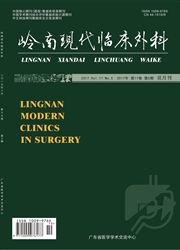

 中文摘要:
中文摘要:
目的探讨腹腔镜后入路胰十二指肠切除术(paLPD)切除过程中相关血管和外科平面的局部解剖学特点。方法通过对我院25例接受paLPD患者手术过程的回顾以及15具尸体标本进行解剖学观察,总结有助于在腹腔镜视野下对paLPD切除过程中相关血管进行准确定位的解剖标志和显露方法,并寻找安全的外科平面。结果胰十二指肠后方与肾前筋膜的无血管间隙、胰颈后方与肠系膜上静脉前面之间的无血管间隙、胰腺钩突与肠系膜血管之间、腹腔干和肝十二指肠韧带区域是paLPD切除过程中重要的四个外科平面,手术相关血管全部涵盖在这四个外科平面内。paLPD中循正确的外科平面进行操作,不仅可以减少血管损伤的几率,提高手术效率,也更加符合肿瘤“整块切除”的原则。结论paLPD是LPD中安全可行的一种手术人路,掌握腹腔镜视野下相关血管的解剖学特点。依正确的外科平面进行操作.可提高手术的安全性和效率。
 英文摘要:
英文摘要:
Objective To invesgate regional anatomy features of related vessels and surgical planes in posterior approach laparoscopic pancreatieoduodenectomy (paLPD). Methods In order to distinguish related vessels in paLPD accurately, we explored anatomy symbols, exposure methods and search for safe surgical planes under laparoscopic visions by means of analysis from 25 patients surgery videos and observing anatomy features of 15 adult specimens. Results Four regions are identified as important surgical planes in paLPD,including the avascular region between posterior pancreas duodenum and prerenal fascia,the avaseular region between posterior pancreatic neck and superior mesenteric vein, the region between pancreatic uncinate process and mesenteric vessels, and the celiac trunk and hepatoduodenal ligament regions,and they cover all related vessels in paLPD. Operating along accurate surgical planes ,we can not only reduce vessels injury risks, but also improve surgery efficiency and follow the "en bloc" principle better. Conclusion paPLD is a safety and feasible way in LPD, and we can improve surgery safety and efficiency by mastering the features of related vessels under laparoscopic visions and operating along accurate surgical planes.
 同期刊论文项目
同期刊论文项目
 同项目期刊论文
同项目期刊论文
 期刊信息
期刊信息
